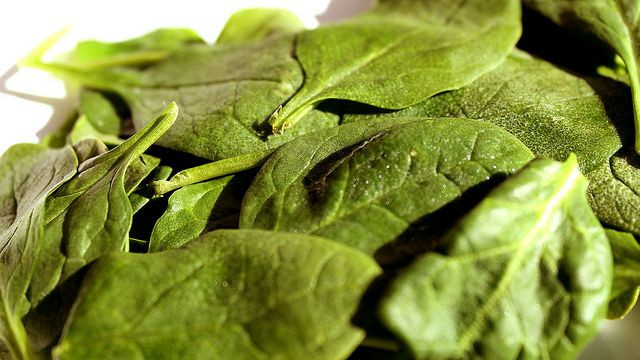Dirty Greens: If You Don't Wash Your Spinach, You May Be Eating Salmonella or E. Coli

As you may or may not be aware, fruits and vegetables are dirty. No matter how washed you think your produce is, there’s a chance it didn’t get washed well, or at all. You’ve read about the deplorable conditions at cilantro farms, and how that has led to outbreaks of cyclosporiasis, which is no picnic. Pre-washed foods lead some people to eat it straight from the bag, without a care in the world, but you might want to reconsider doing that if it’s spinach you're consuming.
According to food safety researchers out of the University of California, Riverside, bacteria like E. coli and Salmonella can survive the bleaching process used in some food processing plants because of the many folds and contours of the leafy greens. Those contours and folds are so pronounced that only 15 percent of a typical spinach leaf is exposed to disinfectant. The researchers took that supposedly triple-washed spinach, which had been supposedly run under a disinfectant of 50 to 200 parts per million of bleach to the water, and washed it themselves with the same disinfectant. They found that nearly 90 percent of the bacteria was still alive and well on the spinach.
“It was surprising to discover how the leaf surface formed micro-environments that reduce the bleach concentration and in this case the very disinfection processes intended to clean, remove, and prevent contamination was found to be the potential pathway to amplifying foodborne outbreaks,” said Nichola M. Kinsinger, a post-doctoral researcher on the study.
What do you do, then, to avoid getting these bacteria onto the foods you intend to eat? Obviously, the correct answer would be to wash them yourself. Well… “Rinsing isn’t going to do a whole heck of a lot for food safety,” Dr. Benjamin Chapman, an assistant professor and food safety extension specialist at North Carolina State University, told Yahoo Health. That will get rid of the things you can see — dirt or other physical objects. But if you really want to ensure that your spinach is bacteria free, you’ll have to cook it.
Though it may seem shocking that the spinach you’ve trusted to appear on your dinner table probably had bacteria covering it, it’s not that surprising to anyone in the food safety community. There was a strain of E. coli outbreak in 2006 that affected 26 states and killed three people. A separate outbreak in 2012 infected 33 people in five states.
Though there is no one definite answer as to how to handle produce, some experts say that eating fruits and vegetables may outweigh the risk of catching a disease. So, depending on how brave you are, eat the spinach out of the bag and let the wheel spin. If you’re not feeling brave but eat spinach like Popeye, cook it first.
Published by Medicaldaily.com



























